Every gardener or landscaper has struggled with weeds at some point. Left unchecked, weeds can take over your landscape, threatening the health and beauty of your plants. To help you maintain a pristine landscape, we will delve into the secrets of effective weed control. We will explore the power behind weed killers, discussing the science, selection process, and practical application to ensure you make the most of these essential gardening tools.
Understanding Weeds: The First Step to Effective Control
What are Weeds?
Weeds are plants growing where they’re not wanted. They can be native or exotic, annual or perennial. Some are dangerous, causing harm to humans and pets, while others are invasive, crowding out desired plants and monopolizing resources. If you are looking for help with your weed, click here.
The Impact of Weeds on Your Landscape
Weeds are more than just an eyesore. They can impact your landscape negatively in several ways:
- Competition for Resources: Weeds compete with your desired plants for nutrients, water, and sunlight. As they are often faster-growing and more hardy, they can quickly out-compete your plants, leading to stunted growth or even plant death.
- Habitat for Pests: Many weeds can host harmful pests or diseases, which can spread to your plants.
- Aesthetic Damage: Weeds can ruin the visual appeal of your landscape, appearing unkempt and distracting from your carefully chosen plants.
The Weed Lifecycle: An Essential Understanding
The key to effective weed control lies in understanding the weed lifecycle. Weeds reproduce either through seeds or vegetative parts, like roots or stems. To control weeds effectively, disrupting their life cycle is crucial, preventing them from reaching the reproductive stage.
The Power of Weed Killers
The Science Behind Weed Killers
Weed killers, also known as herbicides, work by interfering with the growth of weeds. There are two primary categories:
- Pre-emergent herbicides: These herbicides work by preventing weed seeds from germinating. They form a chemical barrier in the soil that stops the weed seeds from sprouting.
- Post-emergent herbicides: These are designed to kill weeds that have already emerged from the ground. They work by interfering with the weed’s ability to photosynthesize, grow, or develop, leading to its death.
How to Choose the Right Weed Killer
Choosing the right weed killer depends on several factors:
- Weed Type: Identify the weed you’re dealing with. Some herbicides are designed for broadleaf weeds, while others target grassy weeds.
- Area of Application: Where you’ll apply the weed killer can influence your choice. Some herbicides may not be safe for vegetable gardens or around certain types of plants.
- Timing: Consider the lifecycle of the weed. A pre-emergent herbicide is your best bet if the weed is still a seed. If it has already sprouted, you’ll need a post-emergent herbicide.
- Environmental Impact: Some herbicides are more environmentally friendly than others. If this is a concern, look for organic or natural weed killers.
Using Weed Killers Safely and Effectively
For effective weed control, proper application is critical. Always read and follow the instructions on the herbicide label. This includes wearing appropriate protective gear, applying the correct amount, and applying at the right time.
Beyond Weed Killers: Integrated Weed Management
While weed killers are powerful tools, they’re just part of an integrated weed management approach.
Cultural Practices
Good gardening practices can go a long way in preventing weed problems. These include:
- Proper Planting: Plant your desired plants close together to leave less room for weeds.
- Mulching: Mulch can prevent weed seeds from reaching the soil and germinating.
- Regular Maintenance: Regular weeding can help keep the weed population under control.
Biological Controls
Some beneficial insects, animals, and even other plants can help control weeds. For example, certain beetles and weevils are known to feed on specific types of weeds.
Mechanical and Manual Control
This includes methods like pulling, hoeing, and mowing. While labour-intensive, these methods can effectively control small weed populations or in combination with other control methods.
Conclusion: Achieving a Pristine Landscape
Effective weed control is critical to maintaining a healthy and beautiful landscape. By understanding the science behind weed killers and how to choose and use them correctly, you can significantly reduce your weed problems. However, remember that weed killers are just one tool. Incorporating cultural, biological, and mechanical controls into your weed management strategy can yield better results.
Maintaining a pristine landscape takes time, patience, and a strategic approach to weed control. But the results – a lush, beautiful, and weed-free landscape – are well worth the effort.

